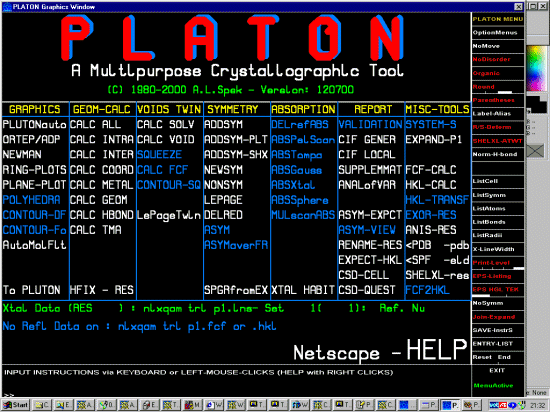For Platon for Windows, open a structure file using the File, Open command then select Platon, PLATON Menu to view the common platon menu options.

Platon's Addsym Manual - by Ton Spek
|
|
The Addsym function within Platon should be considered a mandatory tool
for any small molecule crystallographer and powder diffractionist involved in
solving and refining crystal structures. Addsym "(building on Yvon LePage's
powerful published MISSYM (C) algorithm)" allows the identification
of missed symmetry; which minimizes the chances
of publishing structures in the wrong spacegroup. It can also identify
miss-fitting atoms for the benefit of the crystallographer who can then
check if these are legitimately breaking a possible better symmetry.
Addsym is "also" applicable to
inorganic structures, mineral structures and structures solved and refined
using powder diffraction methods.
Platon makes this type of check quite trivial and easy to do for all structures: just run Platon for UNIX or Windows and open either a CIF, Shelx or Platon file. More compelling reasons for routinely do this are in the following webpage on "Cases of Pseudo Symmetry or real missed Symmetry in the CSD".
|
|
In this example, we will be concentrating on the example based on the
"Short Communication", Acta Cryst B56 (2000) 744 from Richard E. Marsh.
The NIXQAM structure was originally published as triclinic with a spacegroup of P1, reinterpreted by Richard Marsh as monoclinic with spacegroup of C2, then shown by Platon Addsym to be Orthorhombic with spacegroup of Fdd2.
Short Communication Abstract: "P1 or P-1? Corrigendum", Acta Cryst B56 (2000) 744 from Richard E. MarshSynopsis: The space group of bis((phenyl-O,N,N-azoxy)oxy)methane, previously revised from P1 to C2, is further revised to Fdd2.Abstract: The structure of bis((phenyl-O,N,N-azoxy)oxy)methane. C13H12N4O4, originally reported as triclinic, space group P1 [Zyuzin et al. (1997). Isz. Akad. Nauk SSSR Ser. Khim. pp. 1486-1492; CSD recode NIXQAM] was recently revised to monoclinic, space group C2 [Marsh (1999)]. Acta Cryst. B55, 931-936]. It is properly described as orthorhombic, space group Fdd2.
Extracts from the short communication:"While the deviations of these angles from 90� are somewhat greater than the reported precision estimates of ~0.07� (Zyuzin et al., 1997), they are not out of line with the accuracies that are often encountered (Taylor & Kennard, 1986; Marsh, 1995).""Perhaps a word of caution is in order: there may be danger in assuming that the symmetry of a reported structure should be revised without access to the basic experimental data. However, the danger seems minimal in the present case, where the reported structure conforms to the higher symmetry within such small deviations; since the structure obeys the symmetry of Fdd2" (Laue group, mmm, the original data must do the same. Where examination of the original data - particularly the very weak reflections - may be vitally important is in cases involving the ambiguity between a centrosymmetric and a noncentrosymmetric strutcure within the same Laue group, since seemingly important distortions from centrosymmetry may be reflected in only minimal changes in all but the very weakest diffractin intensitiess." |
Downloadable structure filesThe relevant Cambridge structure Database files can be downloaded below:
|
|
If running Platon for UNIX, just type platon filename.ins, platon filename.res
or platon filename.cif to enter the Shelx or CIF file.
For Platon for Windows, open a structure file using the File, Open command then select Platon, PLATON Menu to view the common platon menu options.
|
|
Selecting PLUTONauto will allow you to view and manipulate the structure.
Following is the P1 triclinic structure viewed in the Pluton mode of Platon.
|
|
Following is the C2 monoclinic structure viewed in the Pluton mode of Platon.
|
|
Load the original Triclinic structure in Platon.
Select ADDSYM (under Symmetry) and hang back and let Platon do
the rest. In this case, Platon has found the extra symmetry
and is suggesting the orthorhombic Fdd2 is a better spacegroup for this structure.
|
|
The results are in the "Platon Dialog Window", examine then and
determine for yourself if Platon is onto something. There is move
voluminous output if you wish to examine this.
|
|
If you instead run Addsym-PLT, a structural output will be generated to
the screen. Or the resulting structure can be outputted
directly to a Shelx *.res file
using the ADDSYM-SHX menu option.
|
|
Pluton can also give packing diagrams very easily using the pack range option.
|